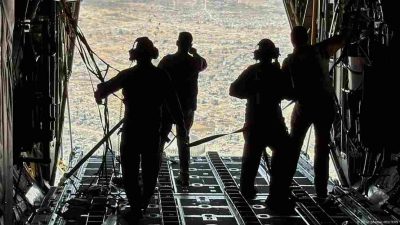
Some countries are using airplanes to launch groceries at the Palestinian enclave. But NGOs criticize measure as “symbolic” and “ineffective” and say that only the reestablishment of land routes will be able to contain hunger.
The extent of hunger that Palestinians face in Gaza has no parallel this century, warned Ross Smith, UN World Food Program (PMA) emergency response director. “Recalls previous disasters in Ethiopia or Biafra in the last century,” he said. “This is not a warning, but a call to action.”
The “worse scenario of hunger” is taking place in the Gaza Strip, IPC Hunger Monitor also said, an initiative that monitors the food situation in Gaza in cooperation with UN agencies.
The report states that the limits to hunger have already been exceeded throughout the geographical territory, and that the limits to acute malnutrition, which can cause serious complications and lead to death, have been surpassed in the city of Gaza.
Much of the more than two million inhabitants of the Gaza Strip now live in precarious conditions in refugee camps, because the Israeli army has declared much of the 365 square miles of the territory as a military exclusion zone.
Israeli Prime Minister Benjamin Netanyahu said he recently said that “there is no hunger in the Gaza Strip.” Since the beginning of the war, Israel has almost completely denied journalists’ access to the area, making it impossible to evaluate the situation independently.
“Cynicism”, “symbolic policy” and “waste of money”
In recent days, some international reliefs have been looking for ways to try acute hunger: on Sunday, military aircraft from Jordan and the United Arab Emirates have launched 25 tons of help supplies on Palestinian territory.
Germany and France also announced their own air release missions. “This action may only be a small humanitarian contribution, but send an important signal: we are there, we are in the region, helping,” said German federal chancellor Friedrich Merz.
But humanitarian organizations are shocked. “Launching humanitarian aid from the air is a useless initiative that smells like cynicism,” said Jean Guy Vataux, emergency coordinator for the Médicos Without Borders.
The Berlin -based Think Center for Humanitarian Action (Cha) called it “the most meaningless air bridge of all time” and “symbolic policy and waste of money”. According to its director, Ralf Südhoff, air transport is up to 35 times more expensive than land trains.
 Jordanian Soldiers on a Gaza Air Launch Mission on July 28 | Jehad Shelbak/Reuters
Jordanian Soldiers on a Gaza Air Launch Mission on July 28 | Jehad Shelbak/Reuters
Air releases do not reach the most needy
Marvin Fürderer, emergency aid expert at German civil organization Welthungerhilfe, speaks of “symbolic and ineffective launches”. To DW, it describes a fundamental problem: “The load is launched without development, without a designated launch zone, without safety structures in a high risk environment.”
Help often does not reach the people who need it most, “but true that still have enough mobility to cross the rubble and the streets crowded to the launch zone and fight for load on site,” says Fürdrer.
Almost every day, deaths around the few distribution centers of the controversial Gaza Humanitarian Foundation (GHF) are related. Based on the United States, the organization has been in charge of distributing a help in the Gaza range since May, with President Donald Trump’s assessment, after Israel has forbade a UN Palestinians, Unrwa, to operate independently at the enclave.
 Getting humanitarian help in Gaza is often dangerous: these Palestinians witnessed deadly shootings in June at a distribution center | GISLAM STEVEN/DW
Getting humanitarian help in Gaza is often dangerous: these Palestinians witnessed deadly shootings in June at a distribution center | GISLAM STEVEN/DW
However, GHF failed to guarantee safety in distribution centers. In addition, according to the UN, the Israeli military repeatedly triggers at people waiting in line. From May 27 and July 21, according to the United Nations High Human Rights Commissioner, more than a thousand Palestinians were killed by Israeli soldiers while trying to obtain humanitarian aid supplies.
Only via terrestrial could supply territory
Humanitarian organizations are requesting free passage from humanitarian aid supplies to the Gaza Strip and the return to the old system: instead of being delivered to some specific points, foods were distributed in a decentralized manner at about 600 distribution points.
Riad Othman, a Middle East specialist at the international medical organization, said at a press conference in Berlin: “Before 7 October 2023, 500 to 600 trucks per day supplied the population and Gaza’s economy.
A truck usually takes about 20 tons of emergency supplies, which often include, in addition to food, medical products and drinking water.
On October 7, Hamas killed more than 1,200 people in Israel in a coordinated terrorist attack and kidnapped another 250 hostages in the Gaza Strip. Israel then declared its military goal of destroying Hamas, but also accepted tens of thousands of civilian victims and the wide destruction of the Gaza Strip. The Gaza Health Authority reports more than 60,000 deaths, including at least 147 by inanition.
 According to the Gaza Health Authority, at least 147 Palestinians have already starved, including 88 children | Jehad Alshrafi/AP Photo/Picture Alliance
According to the Gaza Health Authority, at least 147 Palestinians have already starved, including 88 children | Jehad Alshrafi/AP Photo/Picture Alliance
After the end of the ceasefire in March, Israel blocked all deliveries for more than 80 days. A few days ago, the Israeli army has been taking daily pauses in the fighting in the Gaza Strip and allowing for more help deliveries. Netanyahu Security Minister Itamar Ben-Gvir, from an ultra-right party, criticized the measure as “life support for the enemy.”
Julia Duchrow, Secretary-General of Amnesty International in Germany, said: “There is wide evidence that Israel is using hunger as a weapon of war.” She asked the German government to stop providing weapons to Israel and to increase diplomatic pressure on the Netanyahu government.
“Trains can leave within hours”
The Israeli government denied access of many non -governmental organizations in the Gaza Strip; Even today, can currently provide help through local partner organizations.
Marvin Fürdrer defends the permanent ceasefire and the opening of the border passages for the appropriate humanitarian aid. Thus, Welthugungerhilfe could take Jordan goods to the Gaza Strip within hours, he said. “These trains could start from a few hours, so political conditions did not allow locally.”
 Rafah’s passage, on the border with Egypt, is the main point of entry of terrestrial humanitarian aid to Gaza | Ahmed Sayed/Anadoli Agency/Imago
Rafah’s passage, on the border with Egypt, is the main point of entry of terrestrial humanitarian aid to Gaza | Ahmed Sayed/Anadoli Agency/Imago
For airlines already planned, however, the logistics would have to be compensated, which would cause new costs. “It is quite interesting that this is being considered now, in a context where the German government wants to cut the budget for humanitarian aid by 53%. In such a situation, it is spending millions on symbolic and ineffective air launches,” said difficult Fürderer.
The German Air Force already has experience with air releases in Gaza. In 2024, A400m military aircraft conducted aerial release missions for ten weeks. In total, 315 tons of emergency supplies were launched. Based on a minimum humanitarian need of 500 trucks per day, this would cover the needs of the hungry population in the Gaza Strip for about eight hours.
Originally published by DW on 07/31/2025
By David Ehl
Contribution: Jens Thurau
Source: https://www.ocafezinho.com/2025/07/31/por-que-as-ongs-estao-criticando-o-envio-aereo-de-ajuda-em-gaza/

